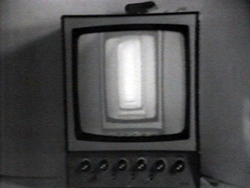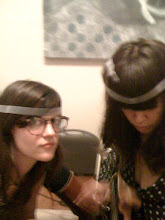I was introduced to Iimura's work through my research on an exhibition and publication with Electronic Arts Intermix, called Vital Signals:Early Japanese Video Art (2010). The work included in the exhibition was Camera, Monitor, Frame from 1976.

Microscope Gallery
4 Charles Place, Brooklyn NY 11221 Tel: 347.925.1433
E-mail: info@microscopegallery.com www.microscopegallery.com
Hours: Thurs to Mon. 1-6PM
Opening Reception:
Sat Mar 19 6pm - 9pm
Takahiko Iimura
BETWEEN THE FRAMES
installation, digital drawing, video, and other new & evolving works by the film & video pioneer
Verbatim from the gallery's site:
TAKAHIKO IIMURA
Between The Frames
w/ live 16mm projection performance of the ever-changing “Circle and a Square”
Microscope Gallery is honored to present the first Brooklyn solo exhibition of the film and video pioneer Takahiko Iimura. Between The Frames is a comprehensive exhibition featuring works made from 1975 to the present, many of which are constantly evolving. The new suspended installation “400 frames” uses ink drawings from 1975. A new print series “MA: The Stones Have Moved” are made from digital drawings related to his 2004 animated video of a Zen garden in Kyoto of the same title. Also on display: Iimura’s famous 1993 “funny faces” silkscreens and video game installation based on Derridda’s “Differance” dealing with physicality of language “AIUEONN Six Features“, never-before-seen sculptures made from 16mm film loop and more.
Iimura has been working with the moving image on film since the 60s and video since the early 70s. After moving to New York in the late 60s became involved with the avant garde scene along side Yoko Ono and Nam Jun Paik and is recognized as one of the most important Japanese artists today. His work is shown widely with numerous solo shows including MoMA, the Whitney Museum, the National Gallery Jeu de Paume, Paris, Reina Sofia National Museum, Madrid, and the Tokyo Metropolitan Museum of Photography, Tokyo. Iimura currently lives and works in Tokyo and NYC.
“His [Iimura’s] Japanese origins contributed decisively to his uncompromising explorations of cinema’s minimalist and conceptual possibilities. He has explored this direction of cinema in greater depth than anyone else. To review all of Iimura’s work…is an important occasion for all who are concerned with the development and pleasure of cinema as an art.” — Jonas Mekas
Please note: Takahiko Iimura is generously donating his proceeds on the sale of sculptures from the series One Second Loop (= Infinity) to the American Red Cross for relief efforts in Japan. Additionally, Microscope Gallery is donating 15 % of the sales of all works of the exhibition.

from video-installation AIUEONN SIX FEATURES, 2′ 30″ (vers. I), 7′ (vers. II), col, sound, 1993
Notes on the screening program (verbatim from program note):
For many years, Japanese experimental film was Takahiko Iimura.
- Malcolm Le Grice, Time Out, London.
In connection with his current exhibition BETWEEN THE FRAMES, Takahiko Iimura brings a selection of his earliest film and video works to the gallery. The evening will be divided into two parts: “60 Experiments” with four 16 mm films made between 1962 & 1964 including his famous AI (LOVE); and “Early Conceptual Videos”, six short video works that contributed to the birth of conceptual video art. A Q&A will follow the screening.
60s EXPERIMENTS
Original 16mm films
Kuzu (Junks)
1962, 10min., b/w, music by Takehisa Kosugi
It’s a mixture of [dead]animals, pieces of [broken] furniture, industrial waste, kids playing. I didn’t have in mind any of the kind of historical perspective, nor was I trying to make an ecological statement. I was showing the new landscape of our civilization. My point of view was animistic. I tried to revive those dead animals metaphorically and to give the junk new life. – - Takahiko Iimura (from “An Interview with Taka Iimura”, Scott MacDonald, Journal of the University Film Association XXXIII, 4, Fall 1981)
Ai (Love)
1962, 10min., blown up from 8mm, b/w, music by Yoko Ono
“I have seen a number of Japanese avantgarde films at the Brussels international Experimental Film Festival, at Cannes, and at other places. Of all those films, Iimura’s LOVE stands out in its beauty and originality, a film poem, with no usual pseudo-surrealist imagery. Closest comparison would be Brakhage’s LOVING or Jack Smith’s FLAMING CREATURES. LOVE is a poetic and sensuous exploration of the body…fluid, direct, beautiful.” – - Jonas Mekas, Film Culture,1966, New York
On Eye Rape
1962, 10min., b/w, silent, Co-Pro. Natsuyuki Nakanishi
The second film (On Eye Rape) was made with footage I picked out of some trash. It was originally an educational film which recorded a plant growing out of the ground. The content isn’t important. I punched almost all the frames with a puncher. I made big holes so that when it was projected, people could barely see what was originally in the frames. I didn’t punch every frame; there was a lot of flicker from the holes. People got very annoyed and complained. They were afraid they would get hurt by the light. That film was called, in English, On Eye Rape (1962). In fact, I had also inserted (a few frames of) *some porno shots. Pornography was forbidden in Japan; It’s still forbidden…. [...] *ps. This is in fact subliminal shots against censorship.” – - Takahiko Iimura (from “An Interview with Taka Iimura”, Scott MacDonald, Journal of The University Film Association XXXIII, 4, Fall 1981)
A dance party in the kingdom of Lilliput
1964, 12min., b/w, sound
A surper-real comedy with Sho Kazakura. The film is divided into a number of very short scenes or chapters, each with a title
“The movie may well be one of the first ‘Conceptual’ film ever made anywhere in the world. It was a rather slow, but clerly defined daily motions of Kazakura, a mysterious underground figure of Japan, who is still unknow in Tokyo, yet has a strange presence in his remote area of Japan, KYUSYU Island.”
- – Nam June Paik, 1987
(Total 42 minutes)
EARLY CONCEPTUAL VIDEOS
After coming back from New York in 1969, I began video production in Tokyo. Working in experimental film since the early 1960s, I first combined the art of film with video, thus making a kind of flicker effect in video in two pieces: “A Chair ” (1970) and “Blinking” (1970). These videos are experiments in perception, and are very minimal formally, consisting mostly of a single object. “Time Tunnel” (1971) is an attempt at time travel in a very conceptual sense. The video combines a repetition of the countdown leader of film, which runs the numbers 10 to 1 , with the feedback effect of video. The result is a tunneling of the numbers in time. ”Man and Woman” (1971) shows the full body of a man and a woman shot from above, in the posture of the drawing of a man by Leonardo Da Vinci, without movement. They are shown alone as well as together one over (or under) the other, narrating in words their positions at the same time. “Visual Logic (and Illogic)” (1977) shows the visual logic (and illogic) of various signs in letters and simple forms on paper combined with limited camera movement and voice-over narration. These early videos constitute the very early experiments of a particular “conceptual video” that almost no other video artists had ever tried at that time. – - Takahiko Iimura
A Chair
1970, 6min., b/w, sound
Blinking
1970, 2min., b/w, sound
Time Tunnel
1971, 5min., b/w, sound
Man and Woman
1971, 2min., b/w
Visual Logic (and Illogic)
1977, 8min., b/w, sound
(Total 23 minutes)







No comments:
Post a Comment